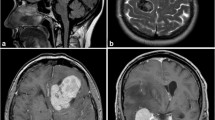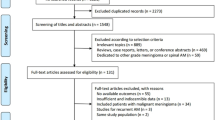Abstract
We investigated possible clinical and histopathological prognostic factors in a malignant meningioma cohort with comprehensive long-term population-based follow-up data. Twenty-four consecutive patients treated surgically for malignant meningioma at the Department of Neurosurgery and the Department of Pathology, Rigshospitalet, Copenhagen, Denmark, from December 2000 to March 2014 were retrospectively evaluated regarding progression-free survival (PFS) and overall survival (OS). Clinical parameters were recorded. All specimens underwent immunohistochemical analysis for Ki-67 and phosphohistone-H3 (PHH3). Prognostication was assessed with Cox proportional hazard regression analysis. The median follow-up was 46.1 months (range 0.7–150.7). The median progression-free survival was 16.5 months (95% CI 11.4–43.0) and the median overall survival was 46.6 months (95% CI 20.4–NA). Six patients were alive at the end of follow-up; two of these had not experienced a recurrence. No clinical parameter showed significant association with PFS or OS. Mitotic index (MI) was significantly associated with PFS and OS, and PHH3 MI with PFS. Immunohistochemical reactivity of Ki-67 > 10% was a negative predictor of PFS (HR 3.92, 95% CI 1.47–10.4, p = 0.0063) and OS (HR 3.35, 95% CI 1.12–10.1, p = 0.0313). The histological subgrouping of grade III meningioma into anaplastic and non-anaplastic revealed increased PFS for the latter (HR 4.57, CI 95% 1.32–15.7, p = 0.0164). We could not verify previous clinical parameters as prognostic factors in malignant meningioma. MI and the PHH3 MI were prognostic within WHO grade III meningiomas for PFS. An overall tumor staining of Ki-67 > 10% correlated with PFS and OS within grade III tumors.

Similar content being viewed by others
References
Abry E, Thomassen IT, Salvesen ØO, Torp SH (2010) The significance of Ki-67/MIB-1 labeling index in human meningiomas: a literature study. Pathol Res Pract 206:810–815. https://doi.org/10.1016/j.prp.2010.09.002
Adeberg S, Hartmann C, Welzel T, Rieken S, Habermehl D, von Deimling A, Combs SE (2012) Long-term outcome after radiotherapy in patients with atypical and malignant meningiomas d clinical results in 85 patients treated in a single institution leading to optimized guidelines for early radiation therapy. 83. https://doi.org/10.1016/j.ijrobp.2011.08.010
Balasubramanian SK, Sharma M, Silva D, Karivedu V, Schmitt P, Stevens GH, Barnett GH, Prayson RA, Elson P, Suh JH, Murphy ES, Chao ST (2017) Longitudinal experience with WHO grade III (anaplastic) meningiomas at a single institution. J Neuro-Oncol 131:555–563. https://doi.org/10.1007/s11060-016-2321-8
Baxter DS, Orrego A, Rosenfeld JV, Mathiesen T (2014) An audit of immunohistochemical marker patterns in meningioma. J Clin Neurosci 21:421–426. https://doi.org/10.1016/j.jocn.2013.06.008
Bi WL, Zhang M, Wu WW, Mei Y, Dunn IF (2016) Meningioma genomics: diagnostic, prognostic, and therapeutic applications. Front Surg 3:1–7. https://doi.org/10.3389/fsurg.2016.00040
Bruna J, Brell M, Ferrer I, Gimenez-Bonafe P, Tortosa A (2007) Ki-67 proliferative index predicts clinical outcome in patients with atypical or anaplastic meningioma. Neuropathology 27:114–120. https://doi.org/10.1111/j.1440-1789.2007.00750.x
Champeaux C, Wilson E, Brandner S, Shieff C, Thorne L (2015) World Health Organization grade III meningiomas. A retrospective study for outcome and prognostic factors assessment. Br J Neurosurg 29:693–698. https://doi.org/10.3109/02688697.2015.1054350
Claus EB, Bondy ML, Schildkraut JM, Wiemels JL, Wrensch M, Black PM (2005) Epidemiology of intracranial meningioma. Neurosurgery 57:1088–1095
Durand A, Labrousse F, Jouvet A, Bauchet L, Kalamaridès M, Menei P, Deruty R, Moreau JJ, Fèvre-Montange M, Guyotat J (2009) WHO grade II and III meningiomas: a study of prognostic factors. J Neuro-Oncol 95:367–375. https://doi.org/10.1007/s11060-009-9934-0
Duregon E, Cassenti A, Pittaro A, Ventura L, Senetta R, Rudà R, Cassoni P (2015) Better see to better agree: phosphohistone H3 increases interobserver agreement in mitotic count for meningioma grading and imposes new specific thresholds. Neuro-Oncology 17:663–669. https://doi.org/10.1093/neuonc/nov002
Ehresman JS, Garzon-Muvdi T, Rogers D, Lim M, Gallia GL, Weingart J, Brem H, Bettegowda C, Chaichana KL (2018) The relevance of Simpson grade resections in modern neurosurgical treatment of World Health Organization grade I, II, and III meningiomas. World Neurosurg 109:e588–e593. https://doi.org/10.1016/j.wneu.2017.10.028
Fathi A-R, Roelcke U (2013) Meningioma. Curr Neurol Neurosci Rep 13:337. https://doi.org/10.1007/s11910-013-0337-4
Fukushima S, Terasaki M, Sakata K, Miyagi N, Kato S, Sugita Y, Shigemori M (2009) Sensitivity and usefulness of anti-phosphohistone-H3 antibody immunostaining for counting mitotic figures in meningioma cases. Brain Tumor Pathol 26:51–57. https://doi.org/10.1007/s10014-009-0249-9
Gerring Z, Pearson JF, Morrin HR, Robinson BA, Harris GC, Walker LC (2015) Phosphohistone H3 outperforms Ki67 as a marker of outcome for breast cancer patients. Histopathology 67:538–547. https://doi.org/10.1111/his.12678
Hua L, Zhu H, Li J, Tang H, Kuang D (2017) Prognostic value of estrogen receptor in WHO grade III meningioma: a long-term follow-up study from a single institution. 1–9. https://doi.org/10.3171/2017.2.JNS162566
Hwang KL, Hwang WL, Bussière MR, Shih HA (2017) The role of radiotherapy in the management of high-grade meningiomas. Chin Clin Oncol 6:S5. https://doi.org/10.21037/cco.2017.06.09
Iwasaki T, Matsushita M, Nonaka D, Kato M, Nagata K, Murakami I, Hayashi K (2015) Phosphohistone-H3 (PHH3) is prognostic relevant in Merkel cell carcinomas but Merkel cell polyomavirus is a more powerful prognostic factor than AJCC clinical stage, PHH3, Ki-67 or mitotic indices. Pathol Int 65:404–409. https://doi.org/10.1111/pin.12305
Kaley T, Barani I, Chamberlain M, McDermott M, Panageas K, Raizer J, Rogers L, Schiff D, Vogelbaum M, Weber D, Wen P (2014) Historical benchmarks for medical therapy trials in surgery- and radiation-refractory meningioma: a RANO review. Neuro-Oncology 16:829–840. https://doi.org/10.1093/neuonc/not330
Katz LM, Hielscher T, Liechty B, Silverman J, Zagzag D, Sen R, Wu P, Golfinos JG, Reuss D, Neidert MC, Wirsching H-G, Baumgarten P, Herold-Mende C, Wick W, Harter PN, Weller M, von Deimling A, Snuderl M, Sen C, Sahm F (2018) Loss of histone H3K27me3 identifies a subset of meningiomas with increased risk of recurrence. Acta Neuropathol 135:955–963. https://doi.org/10.1007/s00401-018-1844-9
Kaur G, Sayegh ET, Larson A, Bloch O, Madden M, Sun MZ, Barani IJ, James CD, Parsa AT (2014) Adjuvant radiotherapy for atypical and malignant meningiomas: a systematic review. Neuro-Oncology 16:628–636. https://doi.org/10.1093/neuonc/nou025
Kim YJ, Ketter R, Steudel WI, Feiden W (2007) Prognostic significance of the mitotic index using the mitosis marker anti-phosphohistone H3 in meningiomas. Am J Clin Pathol 128:118–125. https://doi.org/10.1309/HXUNAG34B3CEFDU8
Kim J-K, Tae-Young J, Shin J, Kyung-Hwa L, Seul-Kee K, Eun Jung L (2016) Meningiomas with rhabdoid or papillary components : prognosis and comparison with anaplastic meningiomas. Korean Neurosurg Soc 59:357–362. https://doi.org/10.3340/jkns.2016.59.4.357
Lim YS, Kim MK, Park BJ, Kim TS, Lim YJ (2013) Long term clinical outcomes of malignant meningiomas. Brain Tumor Res Treat 1:85–90. https://doi.org/10.14791/btrt.2013.1.2.85
Louis, DN (2016) WHO classification of tumours of the central nervous system. International Agency for Research on Cancer, France
Louis D, Ohgaki H, Wiestler O, Cavenee W (2016) WHO classification of tumours of the central nervous system, 4th edn. International Agency for Research on Cancer, World Health Organization, Lyon
Moliterno J, Cope WP, Vartanian ED, Reiner AS, Kellen R, Ogilvie SQ, Huse JT, Gutin PH (2015) Survival in patients treated for anaplastic meningioma. J Neurosurg 123:23–30. https://doi.org/10.3171/2014.10.jns14502
Olar A, Wani KM, Sulman EP, Mansouri A, Zadeh G, Wilson CD, Demonte F, Fuller GN, Aldape KD (2015) Mitotic index is an independent predictor of recurrence-free survival in meningioma. Brain Pathol 25:266–275. https://doi.org/10.1111/bpa.12174
Ozturk Sari S, Taskin OC, Gundogdu G, Yegen G, Onder S, Keskin M, Saglam S, Ozluk Y, Gulluoglu M, Mete O (2016) The impact of phosphohistone-H3-assisted mitotic count and Ki67 score in the determination of tumor grade and prediction of distant metastasis in well-differentiated pancreatic neuroendocrine tumors. Endocr Pathol 27:162–170. https://doi.org/10.1007/s12022-016-9424-9
Perry A, Stafford SL, Scheithauer BW, Suman VJ, Lohse CM (1998) The prognostic significance of MIB-1, p53, and DNA flow cytometry in completely resected primary meningiomas. Cancer 82:2262–2269. https://doi.org/10.1002/(SICI)1097-0142(19980601)82:11<2262::AID-CNCR23>3.0.CO;2-R
Peyre M, Gauchotte G, Giry M, Froehlich S, Pallud J, Graillon T, Bielle F, Cazals-Hatem D, Varlet P, Figarella-Branger D, Loiseau H, Kalamarides M (2017) De novo and secondary anaplastic meningiomas: a study of clinical and histomolecular prognostic factors. Neuro-Oncology 20:1–9. https://doi.org/10.1093/neuonc/nox231
Reszec J, Hermanowicz A, Rutkowski R, Turek G, Mariak Z, Chyczewski L (2015) Expression of MMP-9 and VEGF in meningiomas and their correlation with peritumoral brain edema. Biomed Res Int 2015:1–8. https://doi.org/10.1155/2015/646853
Ribalta T, McCutcheon IE, Aldape KD, Bruner JM, Fuller GN (2004) The mitosis-specific antibody anti-phosphohistone-H3 (PHH3) facilitates rapid reliable grading of meningiomas according to WHO 2000 criteria. Am J Surg Pathol 28:1532–1536. https://doi.org/10.1097/01.pas.0000141389.06925.d5
Rogers L, Barani I, Chamberlain M, Kaley TJ, McDermott M, Raizer J, Schiff D, Weber DC, Wen PY, Vogelbaum MA (2015) Meningiomas: knowledge base, treatment outcomes, and uncertainties. A RANO review. J Neurosurg 122:4–23. https://doi.org/10.3171/2014.7.JNS131644
Rosenberg LA, Prayson RA, Lee J, Reddy C, Chao ST, Barnett GH, Vogelbaum MA, Suh JH (2009) Long-term experience with World Health Organization grade III (malignant) meningiomas at a single institution. Int J Radiat Oncol Biol Phys 74:427–432. https://doi.org/10.1016/j.ijrobp.2008.08.018
Sahm F, Schrimpf D, Stichel D, Jones DTW, Hielscher T, Schefzyk S, Okonechnikov K, Koelsche C, Reuss DE, Capper D, Sturm D, Wirsching HG, Berghoff AS, Baumgarten P, Kratz A, Huang K, Wefers AK, Hovestadt V, Sill M, Ellis HP, Kurian KM, Okuducu AF, Jungk C, Drueschler K, Schick M, Bewerunge-Hudler M, Mawrin C, Seiz-Rosenhagen M, Ketter R, Simon M, Westphal M, Lamszus K, Becker A, Koch A, Schittenhelm J, Rushing EJ, Collins VP, Brehmer S, Chavez L, Platten M, Hänggi D, Unterberg A, Paulus W, Wick W, Pfister SM, Mittelbronn M, Preusser M, Herold-Mende C, Weller M, von Deimling A (2017) DNA methylation-based classification and grading system for meningioma: a multicentre, retrospective analysis. Lancet Oncol 18:682–694. https://doi.org/10.1016/S1470-2045(17)30155-9
Shan B, Zhang J, Song Y, Xu J (2017) Prognostic factors for patients with World Health Organization grade III meningiomas treated at a single center. Medicine (Baltimore) 96:e7385. https://doi.org/10.1097/MD.0000000000007385
Sughrue ME, Sanai N, Shangari G, Parsa AT, Berger MS, McDermott MW (2010) Outcome and survival following primary and repeat surgery for World Health Organization grade III meningiomas. J Neurosurg 113:202–209. https://doi.org/10.3171/2010.1.JNS091114
Winther TL, Arnli MB, Salvesen Ø, Torp SH (2016) Phosphohistone-H3 proliferation index is superior to mitotic index and MIB-1 expression as a predictor of recurrence in human meningiomas. Am J Clin Pathol 146:510–520. https://doi.org/10.1093/ajcp/aqw141
Yang SY, Park CK, Park SH, Kim DG, Chung YS, Jung HW (2008) Atypical and anaplastic meningiomas: prognostic implications of clinicopathological features. J Neurol Neurosurg Psychiatry 79:574–580. https://doi.org/10.1136/jnnp.2007.121582
Yuzawa S, Nishihara H, Tanaka S (2016) Genetic landscape of meningioma. Brain Tumor Pathol 33:237–247. https://doi.org/10.1007/s10014-016-0271-7
Zhang G-J, Zhang G-B, Zhang Y-S, Li H, Li C-B, Zhang L-W, Li D, Wu Z, Zhang J-T (2018) WHO grade III (non-anaplastic) meningioma: our experience in a series of 23 cases. World Neurosurg 112:e754–e762. https://doi.org/10.1016/j.wneu.2018.01.149
Zhang G-J, Zhang Y-S, Zhang G-B, Da L, Zhang L-W, Wu Z, Zhang J-T (2018) Prognostic factors and the management of anaplastic meningioma. Clin Neurol Neurosurg 170:13–19. https://doi.org/10.1016/j.clineuro.2018.03.028
Zhang GJ, Zhang GB, Zhang YS, Li H, Li CB, Zhang LW, Li D, Wu Z, Zhang JT (2018) World Health Organization grade III (nonanaplastic) meningioma: experience in a series of 23 cases. World Neurosurg 112:e754–e762. https://doi.org/10.1016/j.wneu.2018.01.149
Zhao P, Hu M, Zhao M, Ren X, Jiang Z (2015) Prognostic factors for patients with atypical or malignant meningiomas treated at a single center. Neurosurg Rev 38:101–107. https://doi.org/10.1007/s10143-014-0558-2
Funding
This research received no specific grant from any funding agency in the public, commercial, or not-for-profit sectors.
Author information
Authors and Affiliations
Corresponding author
Ethics declarations
Conflict of interest
The authors declare that they have no conflict of interest.
Ethical approval
This study was approved by the Danish Ethical Committee (approval number H-6-2014-010).
Informed consent
The ethical approval granted waiver of informed consent, as the project does not inflict any additional potential health risks to these patients, besides those which they already have been exposed to and are familiar with, in relation to the diagnostic and the therapeutic treatment. Patients who beforehand had denied the use of their leftover diagnostic material in research were not included, but there were no such requests among the cases of interest.
Additional information
Publisher’s note
Springer Nature remains neutral with regard to jurisdictional claims in published maps and institutional affiliations.
Rights and permissions
About this article
Cite this article
Maier, A.D., Bartek, J., Eriksson, F. et al. Clinical and histopathological predictors of outcome in malignant meningioma. Neurosurg Rev 43, 643–653 (2020). https://doi.org/10.1007/s10143-019-01093-5
Received:
Revised:
Accepted:
Published:
Issue Date:
DOI: https://doi.org/10.1007/s10143-019-01093-5




